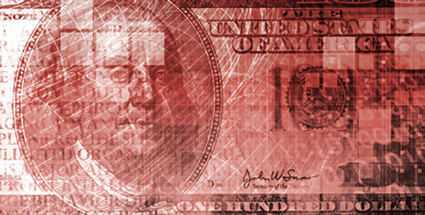If you blinked last week, you might have missed it.
In a span of hours, the U.S. Treasury auctioned off $179 billion in new national debt. So much at once, that yields on three and six-month bills shot up to levels unseen since 2008!
Many investors were caught completely unaware.
But this new torrent of debt is just one stream of a flood that is following the recent suspension of the U.S.’s debt ceiling limit. The U.S. Treasury is rebuilding its cash balance and the market is facing a deluge of sales, even if the government has to pay much higher rates to get the deals done.
Jefferies LLC money market economist Thomas Simons says that the supply of new debt has been so much that the market has had trouble digesting it all.
It is happening so fast, we’re not sure how they can print the money and keep up. The U.S. Gross National Debt has spiked more than $1 trillion in less than six months!
If this sounds like trouble to you, you might want to sit down before reading on. In fact, the government is busy ramping up issuance. Financing estimates from January 2018 indicate that the U.S. Treasury expects to issue a staggering $441 billion in net marketable debt in the current quarter alone!
By mid-year, the Treasury estimates that the total will be over $600 billion in new debt.
This is just the start of the U.S. debt explosion. Seaport Global Holdings managing director of government trading and strategy Tom di Galoma is worried about how much more the market can take.
UNPRECEDENTED DEFICITS AHEAD
A new era of massive federal budget deficits has now arrived in full force.
The ratio of U.S. government debt to Gross Domestic Product (GDP) is reaching levels never before seen in peacetime. Deficits as far as the eye can see are causing interest rates to rise and changing the economic landscape for retirement investors.
The government’s fiscal irresponsibility has implications that could cause the U.S. dollar to weaken. Higher interest rates and a weaker U.S. dollar will curtail any improvements in productivity and constrain economic growth.
In a recent Wall Street Journal op-ed piece, Stanford economist John Cogan blames entitlement spending for the bulk of our nation’s deficits. Programs such as Social Security, Medicare, Medicaid, disability insurance, food stamps, and a host of other welfare programs are popular and help millions, but are also spiraling in cost.
Cogan writes, “since the late 1940s, entitlement claims on the nation’s output of goods and services have risen from less than 4 percent to 14 percent. If left unchecked, these programs will push government spending to levels never seen during peacetime. Financing this spending will require either record levels of taxation or debt.”
Either scenario is damaging and could result in either slower economic growth or inflation.
Central bankers expect inflation to tick higher but remain sanguine about the outlook for world’s largest economy. Higher inflation can be supportive for gold because the metal is often viewed as a hedge against rising prices.
The Fed suggested an “increased likelihood” of further interest rate increases, heightening prospects of a rate rise in March and four rate increases in 2018 as the economy has surged forward.
JANET YELLEN: NATIONAL DEBT HAS ME WORRIED
According to former Federal Reserve Chair Janet Yellen, the spiraling U.S. national debt has her worried.
The bull market in stocks cannot go on forever. The dollar is under threat and inflation is everywhere now in our economy.
Gold is a time-tested asset that offers a hedge against inflation, strong diversification benefits and a simple “sleep better at night” appeal that every investor deserves to enjoy.
Failing to rebalance your portfolio today could have serious deleterious effects on your financial future.






